responses/reviews
Archived Posts from this Category
Archived Posts from this Category
Posted by justin on 20 Nov 2007 | Tagged as: adventure day, art paparazzi, in yo face, possibilities, responses/reviews, silliness
Heres a little recap of the Ken Little performance of Yoko’s “Cut Piece.”
(all photos by Justin Parr, click here for a more extensive folder of images)
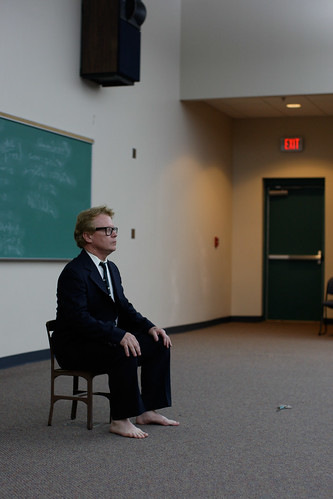
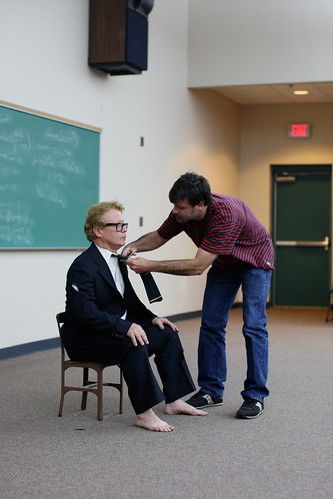

Posted by ben on 13 Nov 2007 | Tagged as: poetry, responses/reviews
This post is a response to Kristy Perez’s recent Chez Bernard (Artist Foundation) show at the Friedrich Building. Photos by Justin Parr.

Love in Return (After Anteros)
When we speak of love we begin with the feet. This is dictated by the movement of the heart, but it suggests the movement of the eyes. Of course the mirrors strip us bare even as they sink into the shoes. At what point does the wheel (the base of the leg apparatus) begin to turn? At what point does our fate return to the nest, gilded and headless (armless, legless)? Should I stop here, love, on the white banks of the river? You’ll find your shoes alone. Never. You’ll find your dissolusion in the air. If you reach the top of the ladder then do we find beauty? Yes I’m saying beauty is dissolusion. My heart brings me back to your feet. And yes those mirrors push me straight up your skirt. I’m building your leg straight through your heart. Don’t look away, love.
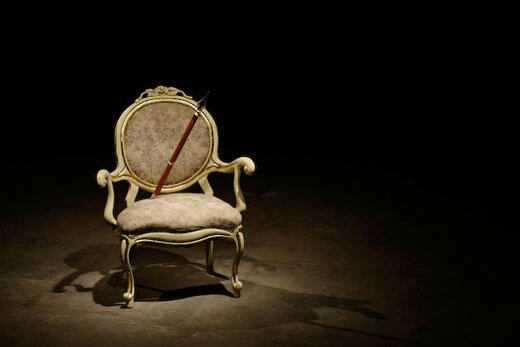
If at First You Don’t Succeed

The Voodoo is High in the Salt and the Oil of Our Air
Posted by ben on 12 Nov 2007 | Tagged as: outsider, responses/reviews
This is the third in a series of posts on publicly accessible outsider art installations in San Antonio, Texas. The first two covered the work of Samuel Mirelez and Rev. Seymour Perkins.
I’ve only just started writing this post, and already I recognize it to be a failure. I’m writing on Ed Clark’s Christmas House [], but I’ve never met Ed Clark, never been inside the house, never seen it in its full lit-up Christmas glory. All I know about the project is what my friend Leigh Anne told me: Ed Clark turned his house into a permanent Christmas-themed installation in honor of his late wife, who loved Christmas. That sound you hear is the shattering of any remaining pretense to journalistic credibility here on Emvergeoning.
So my plan to is show you some good photos of the outside of the house, shot, of course, by Justin Parr, and talk a bit about why I started this little series of posts in the first place.
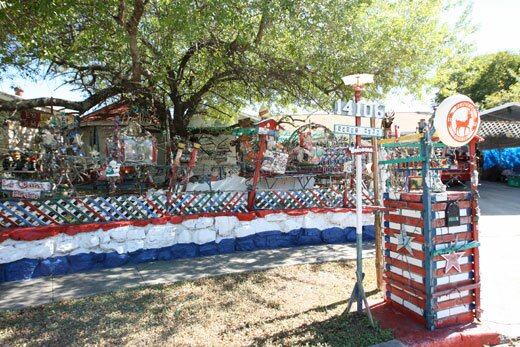
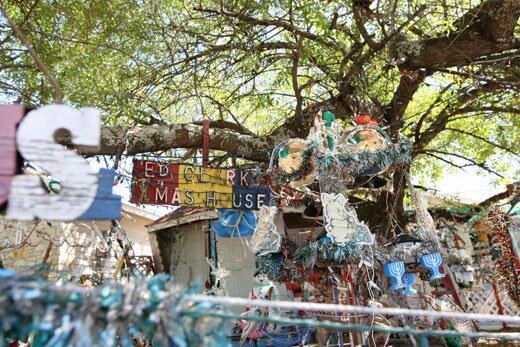
Amid all the chatter about the art market, whether the bubble will burst or whether diamond-encrusted skulls are here to stay, it can be refreshing to look at people working outside of this art world ecosystem. It’s not that these outsiders aren’t ego-driven, or don’t want to be paid for their work, or are somehow more “pure” than a Creative Capital-trained art entrepreneur. But what we see in the work of Samuel Mirelez, or Rev. Seymour Perkins, or Ed Clark is a gesture mediated by the materials and needs of their own private lives. It is no coincidence that these artists turn their homes into installations, or that their works begin simply as gestures of love. While many artists try to universalize their work, to escape the personal, we see these outsiders revel in their own eccentricities to the point where the work becomes an homage to the very fact of being human. So through this work we can see more directly the original motivations, tools, and creative solutions of the artist. You can see the initial, unobscured impulse to create as well as the edifice which is built on top of it.
Continue Reading »
Posted by ben on 05 Nov 2007 | Tagged as: responses/reviews
Katie Pell’s current show at Galeria Ortiz (you belong (here)) explores the relationship between artist and viewer in a more explicit way than artists usually attempt:
Like the framed niches printed on wallpaper adorning French houses and salons, I am presenting works to frame whatever stands before it. Like you. You are a product of a lot of hard work, and this is my version of a standing ovation. Yes, that’s right, this is my standing ovation to you, full of adorable fuzzy creatures of the forest, rock stars, bouquets of flowers and mythical creatures from heaven.
Well, ok, I didn’t see any rock stars, but these mirror-framed pastel drawings do leave a wide-open sky within which to see yourself surrounded by flowers and fuzzy creatures (photos by Justin Parr):

Pell’s decision to frame the viewer twice, first within the reflected gallery environment, then within the dense, baroque flora / fauna scenery is an interesting one, if a bit jarring (and difficult to photograph). What is the viewer to make of this fantastical world, full of happy forest creatures clutching Pixie Stix and Hershey’s kisses, framed by a mirror reflecting white walls, and perhaps a Mondini-Ruiz painting or two? Is the artist celebrating the viewer or projecting an idealized facade, not too different from the idealizations art enthusiasts might project on artists? Why does she expect us to see ourselves in these whispy, pink- and yellow-tinted clouds floating in a baby blue sky?
Pell claims in her statement: “I just want you to feel special” — and I appreciate her attempt to address the relationship between artist and viewer directly, whether she means it or not. I don’t know when the show closes (the flier doesn’t say, and apparently every section of the Galeria Ortiz website is “currently under construction”) but Tuesday morning (November 6), Pell is having a gallery talk at 11:am, which she would prefer you not attend, miracle though you may be. Well, at least she told me not to attend, but maybe you’re more special than I am.

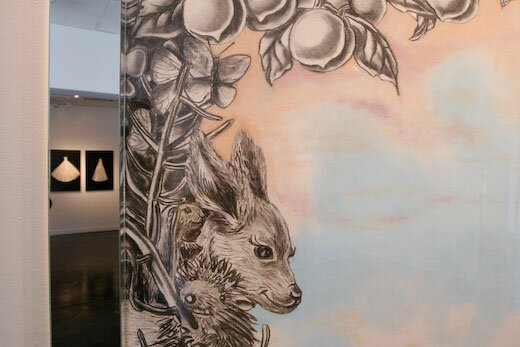
Posted by michelle on 01 Nov 2007 | Tagged as: art paparazzi, responses/reviews
Posted by ben on 31 Oct 2007 | Tagged as: outsider, responses/reviews
This post is the second in a series focusing on publicly accessible outsider art installations in San Antonio, Texas. The first post in this series covered the work of bird house maker Samuel Mirelez. All photos by Justin Parr.
Although San Antonio is considered a well-integrated city, the black population is still for the most part confined to the east side of town. Hackberry Street is one of the main thoroughfares running through the east side near downtown. It is on the corner of Hackberry and Nevada that Rev. Seymour Perkins wages a battle against drugs and violence with art, mythology, and religion. At his home on Hackberry, Rev. Perkins runs Hanging Tough Ministries, Perkins Art School, and The Debbie Jo Christi Museum Project. His ministries began after Perkins’ daughter was killed in drug-related violence. He then started preaching and working in the neighborhood to curtail drug use. In 1999, his church was burned to the ground. Even after this tragedy, Perkins continued to preach from the cement slab on which the church once stood:
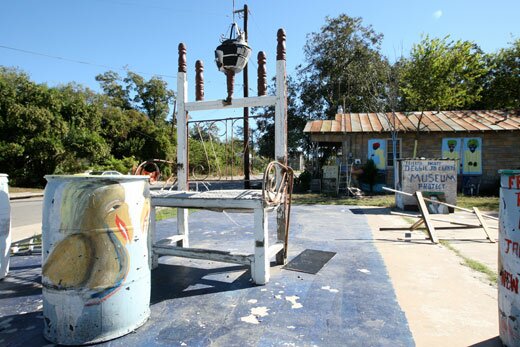
Much of Rev. Perkins’ art celebrates boundary-breaking African-Americans, such as the first black cowboy, Nat Love, the first black college president, Martin Freeman, Sammy Davis, Jr, and Martin Luther King, Jr (you can find some of these portraits at San Angel Folk Art). At other times Perkins uses the art itself to break down barriers, by painting the Statue of Liberty as a black woman, John F. Kennedy, Jr. as a black man, or by painting traditionally white, aristocratic hairpieces on various black figures. By interweaving American mythology with his own visions, Perkins becomes a sort of poetic revisionist, fighting truth with faith. He works as a quixotic figure, trying to break down long-entrenched boundaries and nullify the fear, hatred, and desperation that they have created within his community.
Recently, Rev. Perkins was arrested by San Antonio Police officers after a search turned up drugs in his home. Some claim the drugs were planted there, while others speculate that a member of Perkins’ “congregation”, many of whom use drugs themselves, may have left the substance in his home inadvertently. The artist is out of jail, but his legal fate is uncertain.
You can find the work of Rev. Perkins at the San Angel Folk Art Gallery, and at see his Sculpture Garden at in San Antonio.
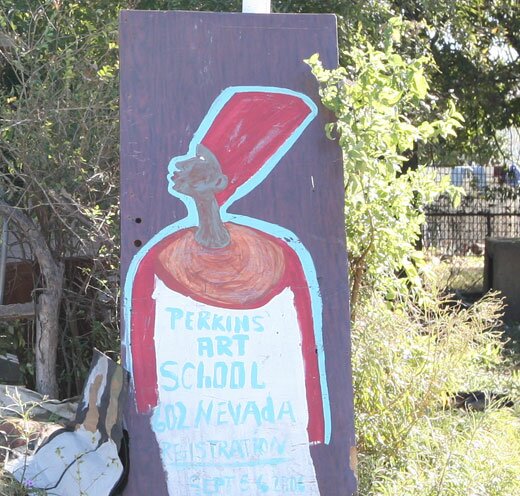
Posted by ben on 27 Oct 2007 | Tagged as: outsider, responses/reviews
This post is the first in a series that will cover some currently active, publicly viewable outsider art installations in San Antonio. We’re starting with Samuel Mirelez because he passed away on September 17 after a long battle with cancer, and the work may only be viewable for a short time. In the coming days we’ll cover Rev. Seymour Perkins and Ed Clark. All photos by Justin Parr.
As with all the artists we’ll be looking at in this series, Samuel Mirelez began his work as a gesture of love. Finding himself in a state of poverty, and with a wedding anniversary fast approaching, Mirelez decided to craft a gift for his wife out of Folger’s coffee cans. Despite the humble materials, the gift was ambitious: a bird house modeled after the San Fernando Cathedral, where the couple wed. The gift was a success, but the choice of materials took its toll; soon, the bird house began to rust and deteriorate. Seeing his wife’s dismay, Mirelez vowed to build a new San Fernando bird house, this time out of aluminum. Soon he found himself building bird houses for his children, his friends, and his coworkers. And he kept building them. He modeled bird houses after castles, Spanish missions, even the White House and the Kremlin. Eventually his yard, front and back, became a permanent installation of avian domiciles (though, strangely, with very few birds):
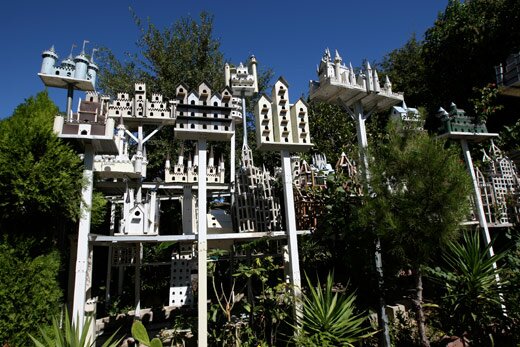
Although he switched to rust-proof metals, he continued to use found materials for all his houses: left over aluminum siding, scraps of wood, and anything else he could find, or that friends would give him. On a recent visit to the Mirelez house, we even spotted a transparent bird house:
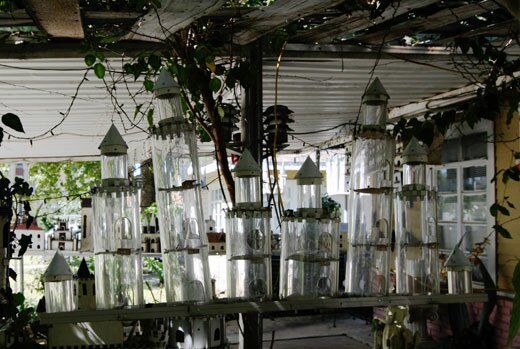
The pieces also became less functional over the years, although they retained an architectural focus. Note this large piece with no walls, but architectural features including arches, spires, and friezes.
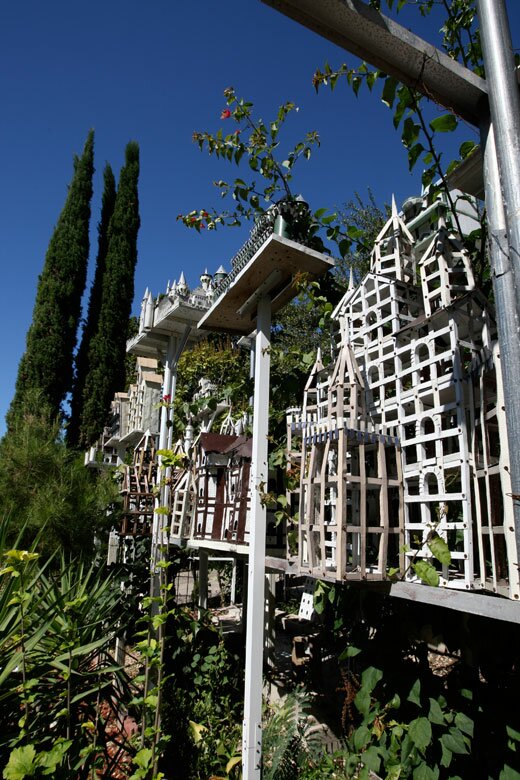
Posted by ben on 26 Oct 2007 | Tagged as: performance art, responses/reviews
Since UTSA art professor Ken Little is doing a performance of Yoko Ono’s Cut Piece tonight, I thought I’d link back to a post I wrote about the piece in the early days of Emvergeoning (the seventh post!). It is a four part response to a video of Ono performing the piece at Carnegie Hall.
Posted by michelle on 23 Oct 2007 | Tagged as: responses/reviews
After all the dust settles from Artpace’s Chalk It Up, looks like Executive Director Matthew Drutt was MIA again, missing the biggest community art event that Artpace organizes for the second year in a row. Apparently eating BBQ in Marfa and sipping cocktails in London are more lucrative endeavors for the local contemporary art director. In the meantime, Artpace is still interviewing for a new curator, any on the potential candidates?
In other news, looks like its a dead end for Volitant Gallery in Austin. That’s the nature of the fickle art market, but Director Xochi Solis says this will give her time to work on individual art projects. Everyone disliked the marble floors and moveable walls, but the gallery had ideal acoustics and voluminous wall space for video installations. The last day to slide across the white marble and catch Femme Fantastique will be October 31st. :(
If you’re in Houston next week, be sure to check out Alejandro Diaz, Chuck Ramirez and the ubiquitous Franco Mondini-Ruiz on Nov. 2nd at a strange place called the New World Museum [sounds like Orwellian territory].
Finally, congratulations to Artlies Magazine for making it to the big leagues: attaining a barcode and a slot alongside every other art magazine in America. It took 8 years of publishing free, quarterly issues before being picked up by a national distributor, so support the lies of art and go buy a copy!
Posted by michelle on 19 Oct 2007 | Tagged as: books, comics, responses/reviews
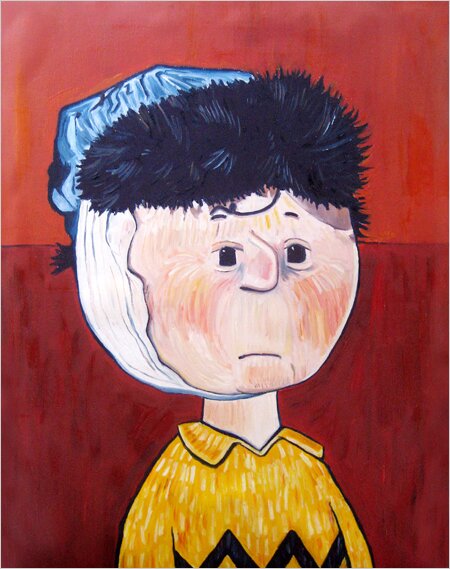
NY Times ran a great article about the tortured life of Peanuts’ creator, Charles Schultz. This graphic by Kim Scafuro had me in stitches. A new biography by David Michaelis spurred the article. Michaelis paints a melancholic picture of the beloved cartoonist, seven years post mortem. Reporter Randy Kennedy makes good use of references from Balzac to Toulouse-Lautrec with lots of levity in between. The last line lets Schultz speak for himself and it makes me wonder if Pig Pen wasn’t Schultz walking around with a little, scribbly cloud hovering above him everyday.
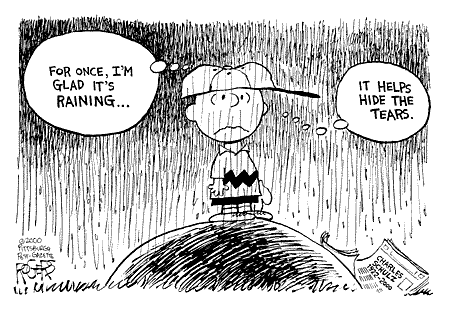
Another excerpt?
Posted by michelle on 15 Oct 2007 | Tagged as: art paparazzi, music, responses/reviews
 The City of Marfa endured an influx of Texas hipsters last weekend. Why would people drive eight hours to a former POW camp in West Texas? A free plate of barbecue courtesy of the Chinati Foundation and the chance to watch Sonic Youth in a small pavilion across the street from a Dairy Queen. San Antonio photographer Patrick Zeller drove out to Marfa and took some great photos of his West Texas journey here. There was a sprawling group show of more than 60 artists at Building 98 called Camp Marfa, a place where you could sit on a couch and watch a sort of Faces of Death version of competitive bull-riding accidents as well as a strikingly poetic series of explosions and slivers of nuclear test documentaries. Fort Russell was once a rest stop for famous generals and various U.S. presidents. The weathered, built in bar still houses a framed, velvet wall that kept high ranking medals. It’s a beautiful example of the art of absence, with the darkened blue velvet beneath the missing medals becoming accidental evidence of importance. There was a big West Texas contingent over at Building 98, with Jeffrey Wheeler at the helm. Wheeler and his brother run a space in Lubbock and started the ongoing, traveling exhibition called Ulterior Motifs. Some of the artists featured in this year’s show include Mel Chin, Bale Creek Allen, Daniel Johnston and Sharon Kopriva. I was in a last minute group show at a renovated restaurant at the edge of town called 500e. Austinites Sean Gaulager, Hank Waddell, Adreon Henry and Jacob Villanueva put the show together on a shoestring and a little bit of help from Vitamin Water and Sapphire Gin.[Sounds awful, but that combination incurs zero hangovers] After Sonic Youth, Adreon Henry’s band played for the meandering crowds. They will be playing again on Halloween if you are in the state capital that day. Over and out. More pictures?
The City of Marfa endured an influx of Texas hipsters last weekend. Why would people drive eight hours to a former POW camp in West Texas? A free plate of barbecue courtesy of the Chinati Foundation and the chance to watch Sonic Youth in a small pavilion across the street from a Dairy Queen. San Antonio photographer Patrick Zeller drove out to Marfa and took some great photos of his West Texas journey here. There was a sprawling group show of more than 60 artists at Building 98 called Camp Marfa, a place where you could sit on a couch and watch a sort of Faces of Death version of competitive bull-riding accidents as well as a strikingly poetic series of explosions and slivers of nuclear test documentaries. Fort Russell was once a rest stop for famous generals and various U.S. presidents. The weathered, built in bar still houses a framed, velvet wall that kept high ranking medals. It’s a beautiful example of the art of absence, with the darkened blue velvet beneath the missing medals becoming accidental evidence of importance. There was a big West Texas contingent over at Building 98, with Jeffrey Wheeler at the helm. Wheeler and his brother run a space in Lubbock and started the ongoing, traveling exhibition called Ulterior Motifs. Some of the artists featured in this year’s show include Mel Chin, Bale Creek Allen, Daniel Johnston and Sharon Kopriva. I was in a last minute group show at a renovated restaurant at the edge of town called 500e. Austinites Sean Gaulager, Hank Waddell, Adreon Henry and Jacob Villanueva put the show together on a shoestring and a little bit of help from Vitamin Water and Sapphire Gin.[Sounds awful, but that combination incurs zero hangovers] After Sonic Youth, Adreon Henry’s band played for the meandering crowds. They will be playing again on Halloween if you are in the state capital that day. Over and out. More pictures?
Posted by ben on 11 Oct 2007 | Tagged as: responses/reviews, silliness
The following comments on the work of Sol LeWitt were sent in by artist, writer, and Emvergeoning reader Chris Karcher. While this piece isn’t a revolutionary reevaluation of LeWitt, I think Karcher’s emphasis on the playful, humorous, and lyrical aspects of LeWitt’s work helps to balance a critical narrative that is too often weighted toward detached conceptualism. I hope you enjoy it.
The two recent exhibits of new work by Sol LeWitt (“Scribble Wall Drawings,” PaceWildenstein Gallery and “A Cube with Scribbled Bands in Four Directions, One Direction on Each Face,” Paula Cooper Gallery – see this Weekend Update at artnet.com) provide an occasion to comment on the legacy of an iconic American artist. This short note is inspired by the fact that LeWitt died in April of 2007, and both exhibits consist of work created after his death.
The catalog produced in conjunction with a retrospective of LeWitt’s work at the San Francisco Museum of Modern Art from 2000 wanders across a lifetime of output starting with early figurative work, then moves on to the geometric work with which he remains closely associated and finishes with the later paintings of irregular brush strokes and lines. LeWitt produced a staggering number of drawings and paintings. In between he oversaw the creation of large numbers of constructions, sculptures and wall drawings. It certainly appears that the man enjoyed making things. And, that he enjoyed painting and drawing.
“The idea itself, even if not made visual, is as much a work of art as any finished product.” LeWitt wrote this in 1967 and it remains, perhaps, the most prevalent conception of what his art was about; the idea, not the output. LeWitt was widely known for his use of other artists to actually create his “finished product,” so it is not unreasonable that people assume Lewitt was above the dirty work of putting pen-to-paper or brush-to-canvas. This notion of the artwork itself not being the point dogged LeWitt throughout his career. Yet his later work is so colorful and lyrical that the label “conceptual” no longer seems to encapsulate it. His comment from 1982, “I would like to produce something I would not be ashamed to show Giotto,” may better speak to LeWitt’s true sensibilities as an artist.
The notion of playfulness seems to escape many discussions about LeWitt and his work. Even such exhausting projects as the “Incomplete Open Cubes” series – with all its manifestations – has, at its core, a jocular sensibility. The cubes as drawings, as photographs, as small sculptures, as big sculptures, in black, in white, all obsessively depict the 122 variations. The doodles evolve into isometric renderings that become little models that become big sculptures that are in turn photographed, all of which are printed in little books and pamphlets. It is not unlike a great shaggy-dog joke. Avoid getting caught up in intellectual analysis and the juxtaposition of an incomplete cube in a gallery filled with baroque and mannerist paintings has its lighter side.
His process of seeking every combination of a series served, among other things, to ensure that LeWitt had plenty of material to work with. Seemingly endless variations of bands in four directions were turned out in seemingly endless varieties of mediums. The consistency of the form allowed for an opportunity to fully explore the interaction of colors, or in the case of sculpture, the interaction of light and shadow. LeWitt repeatedly set strict limits that allowed for infinite variety. Jorge Luis Borges, in an essay tracing the various manifestations of a single thought across time and literature, arrived at a final summation that also describes the work of LeWitt, “an infinite sphere whose center is everywhere and whose circumference is nowhere.”
The art of LeWitt should not be defined by hard logic and cool detachment. LeWitt’s work is better appreciated for the humor, color and inventiveness that Giotto would have enjoyed.
Posted by ben on 08 Oct 2007 | Tagged as: responses/reviews
When I opened up my RSS feeds this morning, I was glad to see Karl Benjamin getting some attention in the NYT. I discovered his work through the wonderful exhibition of Benjamin drawings at Lawrence Markey gallery last year (and I hear Markey is in the process of organizing a showing of Benjamin’s paintings as well). Then I noticed that the eagle-eyed Tyler Green caught a couple of problems in the article.
As Tyler points out, the article claims that the term “hard-edge painting” originated in London, when in fact it was first used in LA. I think I see what happened here; the term “hard-edge painting” was coined by LA Times art critic Jules Langsner, who curated and wrote the text for the catalog of the Four Abstract Classicists show that the NYT (and generally, everyone writing about Benjamin) cited. However, “hard-edge” was not in the title of the show until it traveled to London, and the term was later popularized by British art critic Lawrence Alloway. So Jori Finkel (who wrote the NYT article) seems to have assumed that the term originated with Alloway rather than Langsner. But a quick review of the Wikipedia article could have cleared all of this up.
As for Tyler’s more significant assertion that the NYT tends to talk as if the art world revolves around New York (”the movement offered a Californian counterpart to geometric work by Ellsworth Kelly, Frank Stella and the New York Color Field painters”), that’s less justifiable. Four Abstract Classicists was mounted in 1959, the same year that Stella first began to be recognized in New York.
UPDATE: Tyler Green writes to say that John McLaughlin had been showing since 1953 (and had been painting for 15 years before exhibiting), meaning that he was developing his voice well before even Kelly began showing work. I have wondered if Joseph Albers had been a common inspiration to the California hard-edgers and the early New York minimalists, but haven’t been able to determine if McLaughlin, Benjamin, Lorser Feitelson, or Frederick Hammersley were actually aware of Albers’ work. The New Yorkers were clearly aware of his work, considering his involvement with Black Mountain started in 1933.
Posted by michelle on 01 Oct 2007 | Tagged as: responses/reviews
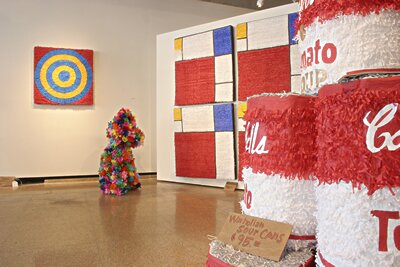
Just a reminder to visit Artpace this week to see the pinata installation that Franco put together this month. Although I’m a little late on this one, you can see more photos from his recent exhibition at Aljira Center for Contemporary Art in New Jersey.
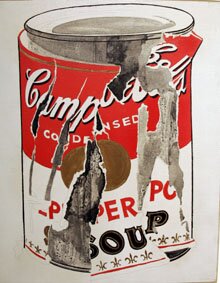

You should start saving your iconic soup cans and pinata paraphernalia, as the BBC reports the Warhol glorified design will cease to exist due to a change in management. One of the original Warhol’s is currently on exhibit at Austin Museum of Art, alongside a giant BLT by Claes Oldenburg. Mmmmm, good.
Posted by michelle on 26 Sep 2007 | Tagged as: arts organizations, responses/reviews
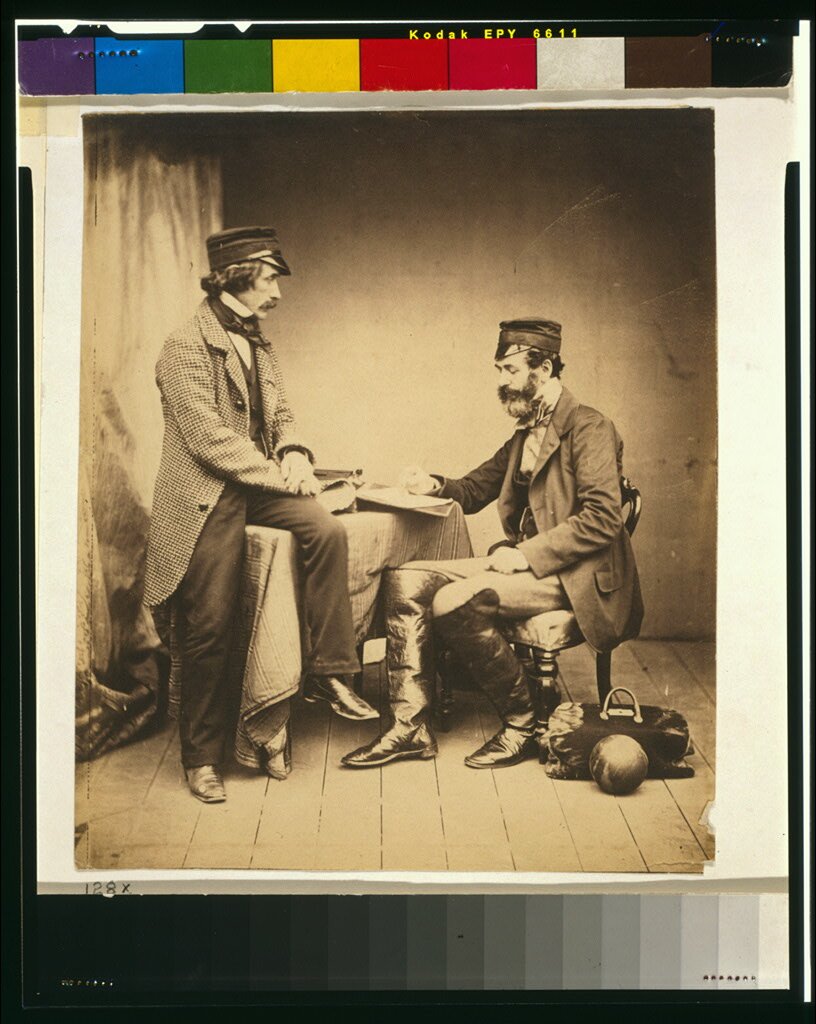 There’s an amazingly long winded Opinion piece by weirdie documentary filmmaker Errol Morris in today’s NYTimes. Morris fixates on a pair of famous photographs taken by Roger Fenton during the Crimean War. The salted paper prints are currently housed in the Harry Ransom Center at UT Austin. The entire article hinges on the ostensible staging of two photos in the “Valley of the Shadow of Death.” After reading a presumptuous Susan Sontag reference to these photos, Morris hopped on a plane to Crimea to investigate. The end result is an absurd conversation, with people measuring shadows and counting cannonballs along a roadside ravine in Crimea. I plucked this Fenton photo [circa 1855] from the Library of Congress’ Prints and Photographs archive, it is entitled “The Sanitary Commission.” *Note the cannonball in the foreground.
There’s an amazingly long winded Opinion piece by weirdie documentary filmmaker Errol Morris in today’s NYTimes. Morris fixates on a pair of famous photographs taken by Roger Fenton during the Crimean War. The salted paper prints are currently housed in the Harry Ransom Center at UT Austin. The entire article hinges on the ostensible staging of two photos in the “Valley of the Shadow of Death.” After reading a presumptuous Susan Sontag reference to these photos, Morris hopped on a plane to Crimea to investigate. The end result is an absurd conversation, with people measuring shadows and counting cannonballs along a roadside ravine in Crimea. I plucked this Fenton photo [circa 1855] from the Library of Congress’ Prints and Photographs archive, it is entitled “The Sanitary Commission.” *Note the cannonball in the foreground.
Posted by michelle on 24 Sep 2007 | Tagged as: art paparazzi, arts organizations, responses/reviews
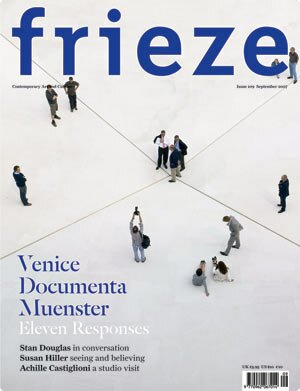
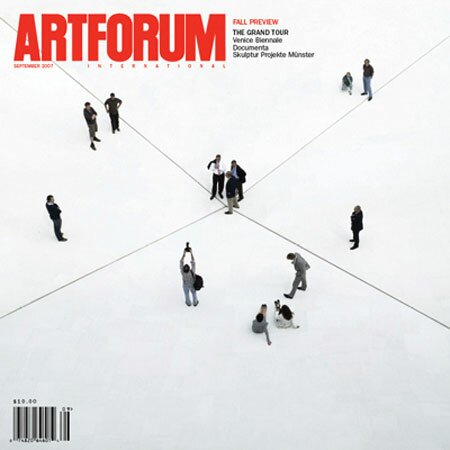
Seems like Bruce Nauman’s Square Depression is the darling of the mega trifecta of biennials in Europe right now. Glasstire also seemed drawn to this image. Perhaps it is the longevity of the work at the hands of American artist Bruce Nauman that keeps his creations piquant. Nauman originally designed this “negative pyramid” in 1977. Abraham Orden at Artnet gives a vivid, succinct observation of this city block-sized sculpture. Somehow the pictures don’t convey the convex element of the work. Has anyone seen photos from the center of this piece?
Posted by ben on 21 Sep 2007 | Tagged as: responses/reviews
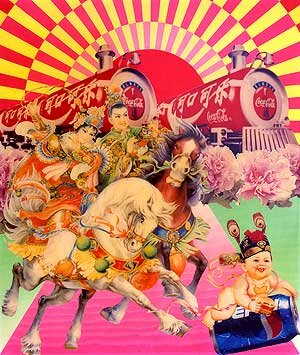 The MFAH’s new exhibit of Asian art, RED HOT, is essentially a study in economics. From the collector-as-investor approach of the Chaney family (from whose collection the show is drawn), to the collector-as-curator approach of MFAH, to the capitalism-comes-to-the-east themes of much of the work, it all boils down to a commentary on the flow of money. And of course, the discussion is framed by those who stand to make the most money out of the show.
The MFAH’s new exhibit of Asian art, RED HOT, is essentially a study in economics. From the collector-as-investor approach of the Chaney family (from whose collection the show is drawn), to the collector-as-curator approach of MFAH, to the capitalism-comes-to-the-east themes of much of the work, it all boils down to a commentary on the flow of money. And of course, the discussion is framed by those who stand to make the most money out of the show.
The Beijing-based Luo Brothers are prominently displayed with their Welcome to the World’s Most Famous Brands series (shown to the left), an exploration of the clash of western brands such as Coca-Cola with traditional Chinese iconography. The Luo Brothers use traditional craft techniques such as wood carving, but finish the work in a way that makes it look almost plastic.
Many of the Japanese artists have thrown themselves into capitalism and consumer culture to a degree rarely seen even in the United States. Artists working for the Japanese art corporation Kaikai Kiki are prominently featured, with two large works by Mr. and two by Chiho Aoshima. Aoshima joined Kaikai Kiki with a degree in ecomonics under her belt, but no formal art training. Both artists explore the fantasy worlds of graphic novels and anime, with a focus on the fragmented, shifting context of a culture that thrives on a never-ending stream of new information. In Mr’s large painting of the Akihabara district in Tokyo, for instance, a dizzying array of costumed characters run through the district, many carrying little worlds in their thought bubbles, creating a chaotic system of divergent contexts. Tellingly, next to the Kaikai Kiki work, a display of Japanese consumer fads such as Speed Racer and Hello Kitty toys gives the ignorant viewer proper context.
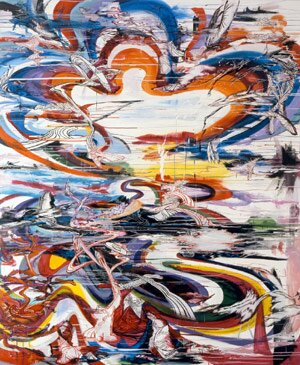 Even when works in the show deal with more universal issues, such as Do Ho Suh’s Karma or Suling Wang’s Open Paths of Origin (shown to the left), the context of the exhibit leads consideration of this work into economic themes. As I discussed Do Ho Suh’s Karma (installed next to the Kaikai Kiki work) with a friend, the conversation kept coming back to economic systems, although the work on its own addresses broader issues of the relationship between the individual and society. Although the concept of karma is, I suppose, a kind of economic system, I think the placement of the work next to Mr’s Penyo-Henyo encourages a narrow reading.
Even when works in the show deal with more universal issues, such as Do Ho Suh’s Karma or Suling Wang’s Open Paths of Origin (shown to the left), the context of the exhibit leads consideration of this work into economic themes. As I discussed Do Ho Suh’s Karma (installed next to the Kaikai Kiki work) with a friend, the conversation kept coming back to economic systems, although the work on its own addresses broader issues of the relationship between the individual and society. Although the concept of karma is, I suppose, a kind of economic system, I think the placement of the work next to Mr’s Penyo-Henyo encourages a narrow reading.
Of course, there’s plenty of interesting work I’m not able to touch on here, and the exhibit is very dense, even cramped. The pieces in the RED HOT exhibit do address important cultural issues from a range of viewpoints, and much of the work is strong; but I have to wonder whether the economic framework set up by the collectors, who are the de facto curators, gives us a distorted view of what is happening in the Asian art world. Or, alternatively, whether it gives us an accurate view of the impact that Western collectors have already made on the art scene in Eastern Asia. In which case, we must wonder to what extent it really is a distinct scene.
And with that Heisenbergian conundrum, I conclude my thoughts on RED HOT.
Posted by michelle on 18 Sep 2007 | Tagged as: art paparazzi, responses/reviews
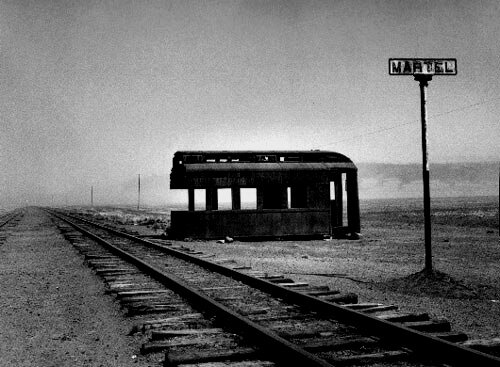
Since we seem to be on the subject of Mexican American art, I stopped by the Instituto Cultural de Mexico in Hemisfair Plaza. It’s a beautiful, spacious building anchored near the Tower of the Americas. The photos on display as part of Fotoseptiembre are black and white images of remote places throughout Mexico. Mariana Yampolsky’s ability to frame fragile subjects in desolate landscapes truly resonates in this overview of her work at the Instituto. Her work dwells in the quixotic realm of fellow photographer Graciela Iturbide, whose work was celebrated at the University of San Marcos’ Wittliff Gallery earlier this year. The Instituto also has an amazing group show called La Caja Museo de Arte Contemporaneo, curated by Martha Papadimitriou. Pick up a catalog to read an insightful essay by author Luis Carlos Emerich in which he explains how the conceptual premise for the show, The Box {La Caja}, “seems to act countercurrent to the formal museum because it forgoes its sanctuary nature.”
Posted by ben on 14 Sep 2007 | Tagged as: arts organizations, responses/reviews
I really didn’t start this blog to write about local politics, but I’ve been in contact with some staff members at the Alameda National Center for Latino Arts and Culture, and some of the things they are telling me need to come out. Rumors have been swirling around the Alameda for months; director Ruth Medellin was apparently forced out back in June, shortly after Laura Esparza left. At lease one board member has been forced out. According to sources, management showed the door to many of Medellin’s friends within weeks of her departure. From what I understand, the entire staff had to reapply for their jobs, and many were let go. Now, this is the kind of thing that happens at nonprofits, and from the outside, it’s hard to tell whether the purge was actually good or bad for the organization.
However, if this string of firings and resignations was the result of a decision to clean up the Alameda, you wouldn’t expect to see Founding Chairman Henry Muñoz III use Alameda staff to set up his personal parties, or his Clinton fundraiser tonight. And you wouldn’t expect him to call Alameda staff in the middle of the night to clean up after these parties at his home. Surely this would be seen as an ethical lapse? I’m hearing from sources at the Alameda that this kind of behavior is typical. I’m hearing that Alameda maintenance staff are often sent to Muñoz’ house to make repairs or do landscaping.
One source, who wished to remain anonymous for fear of retaliation, believes that the Museo Alameda itself is being “offered” for parties thrown by Muñoz’ business associates and potential donors. At these late night soirées, sometimes with hundreds of attendees, alcohol and food is served in the exhibit spaces. And of course, Alameda staff are pulled away from their jobs to set up and clean up the parties. I have not been able to confirm that these parties are thrown at no cost; if the space is being rented for a fair price, many of the ethical concerns over the use of the space vanish.
There are there are also worries about cronyism. Eliseo Rios was recently hired as the director of administration and is a member of the management committee which is charged with running the Alameda temporarily while also searching for Medellin’s replacement. Rios apparently has no experience or qualifications in the art world or the museum world (beyond his work at Alameda); until recently he worked at Cartel Creativo, which handles Latino-targeted advertising for Labatt. He majored in finance and marketing.
Now I think the Alameda is a great thing for San Antonio; I’ve seen some really good contemporary art shows there (e.g. Seis Who), and I think it has fantastic potential to develop a rich narrative or dialectic of Latino culture that embraces the historical and the contemporary. But those who have put in long hours trying to make the Alameda what it is are saddened to see its resources squandered for personal gain. In the wake of the Lawrence Small scandal, we should all be wary of this behavior. As one source says, “We are not Henry Muñoz III, and contrary to popular belief we are NOT HIS museum.”
At the very least the Alameda needs to conduct an internal investigation into Muñoz’ use of Alameda resources for private (non-fund raising) functions. The Alameda receives public funds as well, and this may be a situation in which the city needs to conduct its own investigation. I’d also like to see the Express-News and the Current dig deeper into this story. They have skirted around the issue, but I think we need to get to the heart of it and look at the actions of Henry Muñoz.
Please leave clarifications or any other information you want to share in comments.
Posted by ben on 13 Sep 2007 | Tagged as: design, responses/reviews
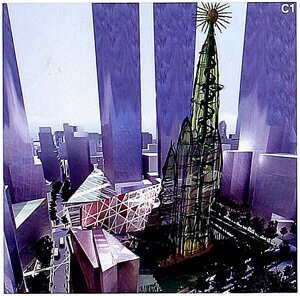 Over at Tyler Green’s house, a long series of posts about art responding to 9/11 is underway. So I thought I’d make a little contribution by way of discussing pre-9/11 work that may provide a vision for a post-9/11 world. In 1908 architect Antoni Gaudi began working on a project called Hotel Attraction for the site which later became the World Trade Center. The hotel, conceived while Gaudi was working on La Pedrera, was abandoned before construction began. The project was unknown to the public until 1956, when one of Gaudi’s assistants produced a set of plans for the 360 meter tall building. There is also another strange connection between Gaudi and Ground Zero. Gaudi was arrested on September 11, 1924 (77 years before the attacks on the World Trade Center) by the totalitarian Spanish government for celebrating the National Day of Catalonia.
Over at Tyler Green’s house, a long series of posts about art responding to 9/11 is underway. So I thought I’d make a little contribution by way of discussing pre-9/11 work that may provide a vision for a post-9/11 world. In 1908 architect Antoni Gaudi began working on a project called Hotel Attraction for the site which later became the World Trade Center. The hotel, conceived while Gaudi was working on La Pedrera, was abandoned before construction began. The project was unknown to the public until 1956, when one of Gaudi’s assistants produced a set of plans for the 360 meter tall building. There is also another strange connection between Gaudi and Ground Zero. Gaudi was arrested on September 11, 1924 (77 years before the attacks on the World Trade Center) by the totalitarian Spanish government for celebrating the National Day of Catalonia.
Now some, including Gaudi followers and visionary artist Paul Laffoley, have proposed that the hotel finally be constructed on Ground Zero. The concept has some interesting implications — in Laffoley’s words, bringing back “architectural ghosts” to create “utopic space“: “It is not Time that heals, it is the Spirit of History.” Rather than dwelling on the traumatic moment, perhaps we ought to reach back and negate that moment with an unrealized possibility from the past.
Posted by michelle on 12 Sep 2007 | Tagged as: responses/reviews

The Museum of Fine Arts Houston offers an eccentric look into the Chaney Family Collection in Red Hot Asian Art Today. Two of Do Ho Suh’s monumental sculptures, Paratrooper and Karma, fill the gallery space with surgical precision and scale-skewed significance. The humorous works of the Luo Brothers brighten up the voluminous space while several animation and video works from Wu Junyong and Takeshi Murata add strange soundtracks to this fantastic exhibition.

Also if you are in U-town, stop by The Station for an interesting juxtaposition of Rice University sculpture professor George Smith’s weighty, stoic steel sculptures, Aime Mpane multi-media installation and James Little’s vibrant, Stella-esque oil and wax canvas paintings. Though they are billed as solo exhibitions in this space, Smith and Little fit together in a harmonious tesseract pattern of elongated triangles. The Station show ends this week and you can still catch the Red Hot Asian Art show through mid-October.
Posted by ben on 06 Sep 2007 | Tagged as: responses/reviews, wordy
Copyright law has given essential protections to artists as long as it has been around, allowing for a legally enforced structure within which to distribute reproductions of artwork. In recent years, with the rise in popularity of sampling and appropriation, it has also been seen as a major obstacle to many artists. Hence the rise of ‘copyleft‘ and Creative Commons, which created a sub-structure within existing copyright laws allowing for certain kinds of reuse and redistribution, while keeping ownership of the work in the hands of the original artist.
Meanwhile, publishing companies, who see copyrighted work as their lifeblood, have struggled to extend and strengthen copyright laws. We have seen the lifespan of a copyright extend from a modest 14 years (with the possibility for a 14 year extension) at the founding of the United States to the entire life of the artist plus 75 years today.
Recently, however, free speech and free culture advocates have been trying to fight back the rising tide of copyright regulations. A major decision was handed down yesterday by the 10th Circuit Court of Appeals regarding these expansions of copyright. They relate specifically to the Uruguay Round Agreements Act (URAA) enacted under Bill Clinton. This act placed certain foreign works under US copyright which had previously been considered part of the public domain in the US. The 10th Circuit found in Golan v. Gonzales that taking works out of the public domain retroactively is unconstitutional requires further scrutiny, invalidating this section of the URAA remanding the URAA to the District Court for First Amendment review.
Lawrence Lessig (who argued the case) believes that this will have major implications for the Supreme Court review of another case, Kahle v. Gonzales, which seeks to overturn the shift from opt-in copyright to opt-out copyright (that is, it used to be that you had to specifically mark something as copyrighted to take it out of the public domain; now, works are copyrighted by default unless the creator specifically chooses to place it in the public domain). More analysis of this important decision can be found at Balkinization.
These decisions have potential to move the balance closer to the ‘culture wants to be free’ side of things, and further from the ‘culture is property’ side, limiting the kinds of laws Congress can pass to further lock down the free flow of information and art.
Posted by ben on 03 Sep 2007 | Tagged as: art paparazzi, responses/reviews
In the interest of debate, let me put in my two cents on the various stabs being taken at Elaine Wolff (both in Michelle’s post below, and in the various articles she links to). In her critique of Olmos Famous, Wolff accuses the show of being too much surface, not enough depth. This assessment isn’t necessarily wrong, but I think it misses the point. Franco Mondini-Ruiz’s shows (both his solo shows and those that he curates) are about spectacle, crowds, and excitement. They aren’t about quiet contemplation of a body of work. He’s working on making the community aware of the quality of contemporary art that is made in San Antonio, of the kind of excitement and energy that can surround this work, and of the fact that you can pack a gallery in Olmos Park with people who live on the north side and the south side. And he’s doing a great job of it.
There is room for other kinds of shows, as Michelle Monseau’s quiet, mysterious, and very spacious exhibit at Blue Star recently demonstrated. Franco just isn’t going to curate those shows. The “fairy god-mother” remark may sound bad from a certain perspective, but knowing Franco, and the degree to which he can dish it out, I have trouble getting worked up about this comment.
Posted by michelle on 03 Sep 2007 | Tagged as: art paparazzi, responses/reviews
San Antonio gives weekly alternative media little to be proud of these days. The SA Current tried to cover up its fatuous reporting with an Eighties inspired graphic re-design but it looks like things are just getting pickled. I wrote a Letter to the Editor, Elaine Wolff, last month for her derogatory and vapid review of the Olmos Famous Show at Galeria Ortiz [Curated by Franco Mondini-Ruiz]. You can’t read it because there is no archival search engine on SA Current’s sparkling new website. Although Wolff posted the letter on her blog, she never published it in the print version.
Wolff is under some serious heat for her dubious coverage of one Mikal Watts and her husband’s deep pockets that connect the local weekly editor to a Texas lawyer’s run for Senate. Did I mention her husband, Michael Westheimer, is a Zoning Commissioner? I’m still working on this story but you can read the Express-News [read Aug. 23 post] and local muckraker, Barbara Gonzalez coverage of the ongoing discussion. In the meantime, I wanted to get things started after I waited a few weeks for possible publication of my letter. I am posting Wolff’s response in tandem. In addition, Wolff just fired news staff writer Kelly Dailey. Fellow writer Dave Maas just left the paper a few weeks ago to work for a weekly in Santa Fe after serious contentions over Wolff’s delayed disclosure.
More news later this week…
Here’s the letter and her response for the Olmos Famous Review:
Posted by michelle on 26 Aug 2007 | Tagged as: responses/reviews
 Bill Daniel breezed through town earlier this year to screen his hobo film, Bozo Texino. He just printed a bunch of amazing photos from Katrina’s aftermath in New Orleans as well as photos of hippy houseboats in northern California. The “Sunset Scavenger” show at Rayco looks fantastic thanks to Daniel’s analog aesthetics when it comes to printing photos the old fashioned way. Highly recommended show if you happen to be strolling around the SFMOMA. More photos…
Bill Daniel breezed through town earlier this year to screen his hobo film, Bozo Texino. He just printed a bunch of amazing photos from Katrina’s aftermath in New Orleans as well as photos of hippy houseboats in northern California. The “Sunset Scavenger” show at Rayco looks fantastic thanks to Daniel’s analog aesthetics when it comes to printing photos the old fashioned way. Highly recommended show if you happen to be strolling around the SFMOMA. More photos…
Continue Reading »